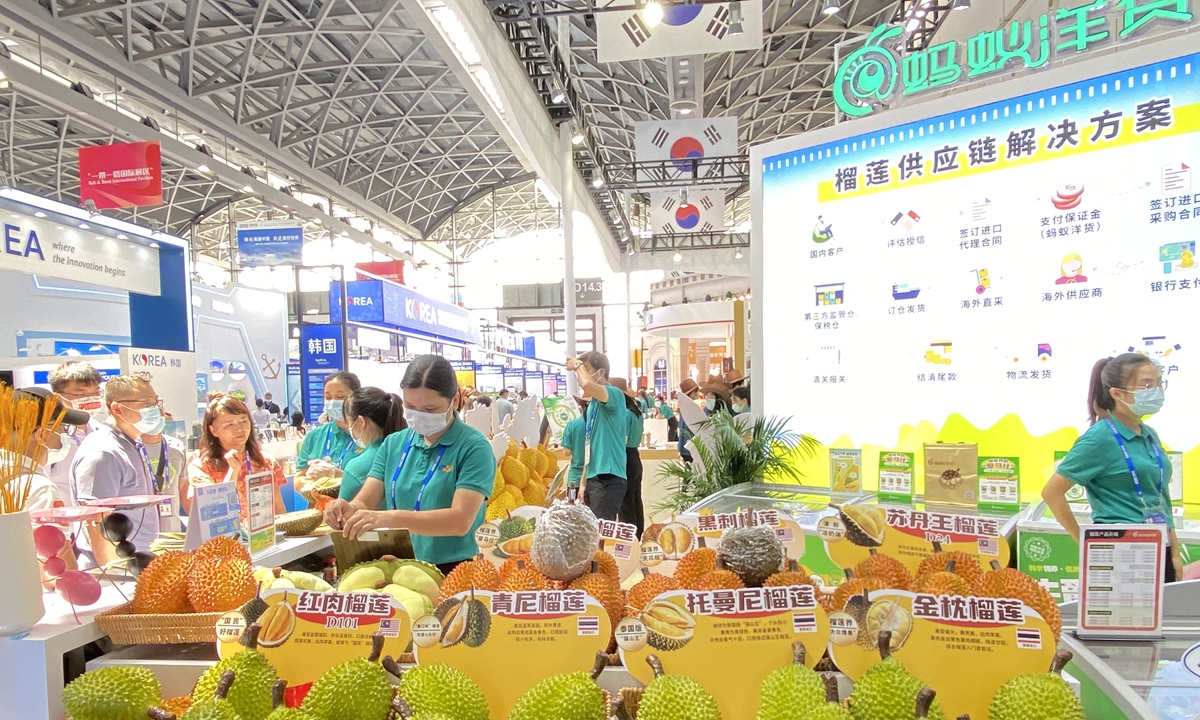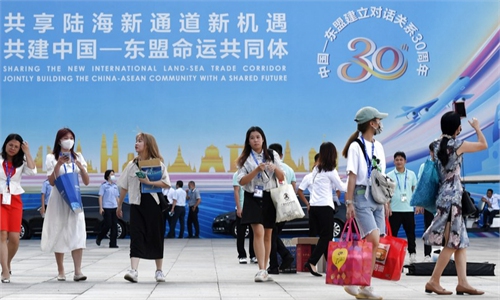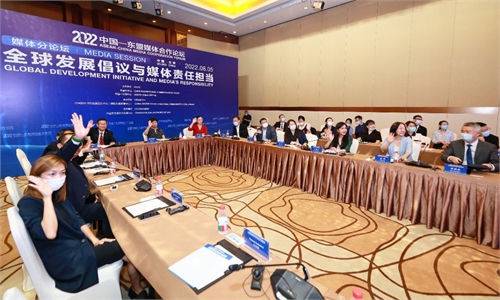First edition of China-ASEAN Expo since RCEP opens, bearing witness to blossoming of closer economic ties

Visitors crowd a stall showcasing Malaysian and Thailand durians at the 19th China-ASEAN Expo (CAEXPO) in Nanning, capital of South China's Guangxi Zhuang Autonomous Region, on September 16, 2022. The four-day CAEXPO has attracted more than 1,600 firms to its in-person event. Photo: Li Qiaoyi/ Global Times
The annual China-ASEAN Expo (CAEXPO), a trade show that bears witness to the blos-soming of economic cooperation between China and the 10-nation regional grouping, opened Friday in Nanning, capital of South China's Guangxi Zhuang Autonomous Region, the first edition of the event since the Regional Comprehensive Economic Partnership (RCEP) went into force at the beginning of the year.
This year marks the first year of the China-ASEAN comprehensive strategic partnership, and it's hoped that both sides can make good use of new opportunities in the wake of the RCEP implementation, continue to expand the opening and cooperative "circle of friends," and build a closer China-ASEAN community with a shared future, Vice Premier Han Zheng said in a keynote speech to the opening of CAEXPO, the Xinhua News Agency reported.
Han urged all sides to enhance bilateral economic and trade cooperation, implement RCEP in a high-quality manner, increase imports of premium products, notably farm produce, from ASEAN, and foster a deep integration of industrial, supply and value chains.
China has unwaveringly expanded opening-up and actively pushed for the creation of a market-oriented, law-abiding and internationalized business environment, according to Han, who made an inspection of the exhibition space after the opening ceremony and interacted with exhibitors.
The RCEP implementation unleashes the potential of a unified big market, injecting strong vitality into China-ASEAN cooperation, the vice premier stated.
Countries from across the globe were welcomed to invest in China, and Chinese businesses were also encouraged to explore international markets, he continued, hoping for the business community to discover opportunities and make greater contributions to regional development.
ASEAN and RCEP bouquet exhibition areas debuted at this year's CAEXPO to showcase wide-ranging products from different countries. The ASEAN and RCEP-themed exhibition space was seen crowded on Friday with visitors trying out speciality foods, skincare and healthcare items, among a variety of products hailing from Japan, South Korea, Thailand, Malaysia and other RCEP member countries.
The RCEP membership encapsulates 10 ASEAN member states and five of their major trading partners - China, Japan, South Korea, Australia and New Zealand.
The mega deal streamlines customs clearances among the member countries, facilitating inter-regional trade and investment, Ai Ma with Apsara Rice (Cambodia) Co, a multiple-time CAEXPO attendee, told the Global Times on Friday at the rice mill factory's booth.
In a speech to the expo opening via video, Cambodian Prime Minister Samdech Techo Hun Sen said that the RCEP implementation starting this year will create and bring more trade opportunities for countries in the region, according to Xinhua.
The China-ASEAN economic cooperation has made many fruitful achievements since the signing of the ASEAN-China Framework Agreement on Comprehensive Economic Coop-eration in 2002 and other free trade and investment deals, Hun Sen said.
Over the years, the two sides had successfully implemented the initial two versions of the China-ASEAN free trade agreement, and that Cambodia supported upgrading this pact to the new 3.0 version, he said.
China's trade with ASEAN members amounted to $544.9 billion in the first seven months of the year, a year-on-year increase of 13.1 percent, accounting for 15 percent of China's total imports and exports, customs data showed.
China has maintained its position as the largest trading partner for ASEAN for 13 years in a row, while ASEAN overtook the EU as China's top merchandise trading partner in 2020 and continued to take the top spot last year.
Additionally, cumulative two-way bilateral investment had exceeded $340 billion by the end of July, per official data.
Hun Sen called on China and ASEAN to focus more on expanding and deepening bilateral economic cooperation, minimizing barriers to goods and services trade and investment, as well as pushing for the development of the digital economy, green growth and small and medium-sized businesses.
The annual expo, which runs through Monday, has attracted 1,653 firms to its in-person event. Meanwhile, more than 2,000 businesses have participated in the online expo, according to a briefing on Thursday.
Some 80 investment and trade promotion activities and 21 high-level forums were sched-uled to be held online and offline during the four-day expo.
Also on Wednesday, plans for the setting up of RCEP national pavilions, among a variety of pavilions in a China-ASEAN featured product convergence center in Nanning, were un-veiled. The center is estimated to be completed in 2025 with a gross floor area of roughly 1 million square meters.



